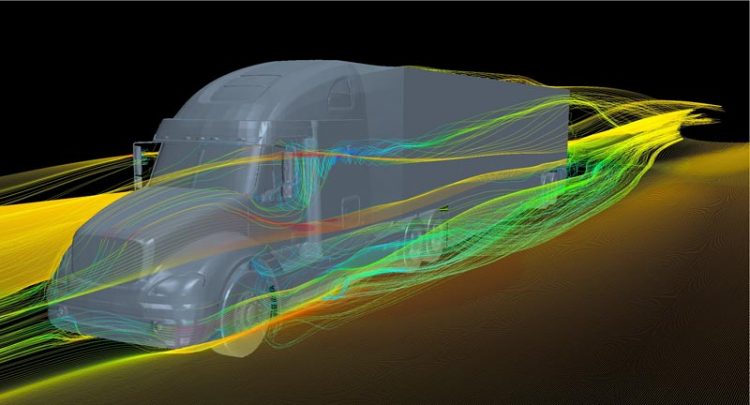How to Save Billions of Gallons of Gasoline

Each year, the more than 2 million tractor-trailer trucks that cruise America's highways consume about 36 billion gallons of diesel fuel, representing more than 10 percent of the nation's entire petroleum use. That fuel consumption could be reduced by billions of gallons a year through the use of drag-reducing devices on trucks, according to studies by researchers at Lawrence Livermore National Laboratory.
The findings will be described today in a talk at the American Physical Society's Division of Fluid Dynamics (DFD) meeting in San Francisco, Calif. A press briefing featuring this and several other talks will be streamed live over the Web from the conference at 1:00 p.m. PST on Monday, Nov. 24 in room Foothill F of the San Francisco Marriott Marquis. For more information, email jbardi@aip.org
Fluid dynamicists Kambiz Salari and Jason Ortega ran aerodynamic tests on a detailed 1/8 scale model of a semi-truck in the wind tunnel facilities at NASA's Ames Research Center at Moffett Federal Airfield in California. The truck was tested in various configurations.
In some, it was outfitted with trailer skirts, which are panels affixed along the lower side edges of a trailer that reduce drag resulting from airflow interacting with wheels and other structures under the body of the trailer; in others, a boat tail fairing, a device affixed to the back of the trailer that decreases drag by reducing the trailer wake size, was added. In still other tests, the truck was rigged with both of the drag-reducing devices (or with neither one).
Salari and Ortega found that adding both of the devices — which are currently used in combination on about three to four percent of the nation's semi-trucks — reduced the aerodynamic drag by as much as 25 percent, which represents about a 13 percent decrease in fuel consumption.
“Even a minor improvement in a truck's fuel economy has a significant impact on its yearly fuel consumption,” Salari said. “For example, 19 percent improvement in fuel economy, which we can achieve, translates to 6.5 billion gallons of diesel fuel saved per year and 66 million fewer tons of carbon dioxide emission into the atmosphere. For diesel fuel costing $3.96 per gallon, the savings is about $26 billion.”
“We are in the process of designing from the ground-up the shape of the next-generation of highly aerodynamic and integrated heavy vehicles to radically decrease aerodynamic drag and improve the fuel efficiency,” Salari said.
ABOUT THE APS DIVISION OF FLUID DYNAMICS
The Division of Fluid Dynamics (DFD) of the American Physical Society (APS) exists for the advancement and diffusion of knowledge of the physics of fluids with special emphasis on the dynamical theories of the liquid, plastic and gaseous states of matter under all conditions of temperature and pressure. DFD Website: http://www.aps.org/units/dfd/index.cfm
Media Contact
All latest news from the category: Power and Electrical Engineering
This topic covers issues related to energy generation, conversion, transportation and consumption and how the industry is addressing the challenge of energy efficiency in general.
innovations-report provides in-depth and informative reports and articles on subjects ranging from wind energy, fuel cell technology, solar energy, geothermal energy, petroleum, gas, nuclear engineering, alternative energy and energy efficiency to fusion, hydrogen and superconductor technologies.
Newest articles

NASA: Mystery of life’s handedness deepens
The mystery of why life uses molecules with specific orientations has deepened with a NASA-funded discovery that RNA — a key molecule thought to have potentially held the instructions for…

What are the effects of historic lithium mining on water quality?
Study reveals low levels of common contaminants but high levels of other elements in waters associated with an abandoned lithium mine. Lithium ore and mining waste from a historic lithium…

Quantum-inspired design boosts efficiency of heat-to-electricity conversion
Rice engineers take unconventional route to improving thermophotovoltaic systems. Researchers at Rice University have found a new way to improve a key element of thermophotovoltaic (TPV) systems, which convert heat…



